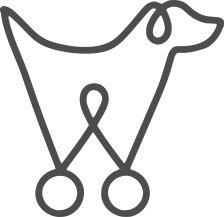I have had quite a few customers asking me about which brush they should use on their pooch, so I have put together a list of different brushes and their uses on different coat types. Hope you find it useful. Here it goes:
Choosing the right brush for your pet is an important first step for even the most basic home grooming.
BRUSH TYPES - Although there are many different shapes and sizes, there are basically three different brush types.
GROOMING TIP:
When brushing, be gentle and take your time. Be especially careful when removing mats or tangles. Brushing can and should be a pleasant experience for your pet as the gentle stroking feels good on your pet's skin. It does not take too many painful 'rips' through snarls, however, to make brushing a procedure your pet will try to avoid rather than invite. The best way to build trust and make this a pleasurable bonding time for both of you is to brush your pet often, preferably daily. This prevents problem mats and tangles from developing.
Bristle brushes: Bristle brushes can be used on all coat types, and vary according to the spacing between bristles and the length of the bristles. In general, the longer the hair coat, the more widely spaced and longer the bristles should be. Also, the coarser the hair, the stiffer those bristles need to be.
Wire-pin brushes: Wire-pin brushes, with or without rubber-tipped ends, are the preferred choice for pets with medium to long hair and those with curly or woolly coats.
Slicker brushes: Slicker brushes have fine wire bristles and are especially useful for removing mats and tangles.
Hair coat types - The right brush and brushing technique will depend on your dog's hair type.
Short, smooth coats (most Retrievers, Hounds, Chihuahuas, etc.): Brush with the coat's grain using a soft to medium bristle brush with short, closely spaced bristles.
Short, wiry coats (Terriers, etc.): Brush with the coat's grain using a slicker brush or a firm bristle brush with short, closely spaced bristles.
Medium to long, flowing coats (Golden Retrievers, Spaniels, Setters, Lhasa Apsos, etc.): Brush with the coat's grain using a wire-pin brush or a soft to medium bristle brush with long, medium- to wide-spaced bristles. Use a slicker brush for mats and tangles.
Harsh, outer coats with soft, woolly undercoats (Sheepdogs, Collies, Shepherds, Chows, Pomeranians, etc.): Brush with the grain on the outer coat and against the grain on the undercoat using a wire-pin brush or a firm bristle brush with long, wide-spaced bristles. Use a slicker brush for tangles and mats.
Thin, delicate coats (Yorkies, Maltese, etc.): Brush with and against the coat's grain using a wire-pin brush and a soft slicker brush for tangles and mats.
There are many benefits of regular brushing. Removal of loose and dead hair and skin is obviously the first benefit. By grooming out any unwanted hair and dandruff, the look of the coat is dramatically improved, allowing a glossier colour and healthy shine. By removing these articles that clog up the coat, air circulation and the health of the skin can be enhanced. The motion of brushing increases blood flow to the dog’s hair follicles also improving the health of the coat and skin, in addition to stimulating the lymphatic system which provides additional health benefits for your dog.
Happy brushing!

